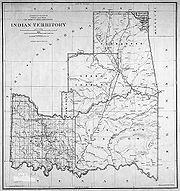Indian Territory

The Indian Territory, also known as the Indian Territories and the Indian Country, was land set aside within the United States for the use of Native Americans. The general borders were set by the Indian Intercourse Act of 1834.
The Indian Territory had its roots in the British Royal Proclamation of 1763, which limited white settlement to Crown lands east of the Appalachian Mountains. Indian Territory was reduced under British administration and again after the American Revolution, until it included only lands west of the Mississippi River.
At the time of the American Revolution, many Native American tribes had long-standing relationships with the British, but a less developed relationship with the American rebels. After the defeat of the British, the Americans twice invaded the Ohio Country and were twice defeated. They finally defeated a Native American confederacy at the Battle of Fallen Timbers in 1794, imposing the unfavorable Treaty of Greenville, which ceded most of what is now Ohio, part of what is now Indiana, and the present day sites of Chicago and Detroit to the United States.

The Indian Territory served as the destination for the policy of Indian Removal, a policy pursued intermittently by American presidents early in the nineteenth century, but aggressively pursued by President Andrew Jackson after the passage of the Indian Removal Act of 1830. The Five Civilized Tribes in the South were the most prominent tribes displaced by the policy, a relocation that came to be known as the Trail of Tears during the Choctaw removals starting in 1831. The trail ended in what is now Arkansas and Oklahoma, where there were already many Native Americans living in the territory, as well as whites and escaped slaves. Other tribes, such as the Delaware, Cheyenne, and Apache were also forced to relocate to the Indian territory.
The Five Civilized Tribes set up towns such as Tulsa, Ardmore, Tahlequah, Tishomingo, Muskogee, and others, which often became some of the larger towns in the state. They also brought their African slaves to Oklahoma, which added to the African-American population in the state. Members of these tribes fought primarily on the side of the Confederacy during the American Civil War in Indian territory. Following the Battle of Doaksville, Brigadier General Stand Watie, a Confederate commander of the Cherokee nation, became the last Confederate general to surrender in the American Civil War on 23 June 1865.
In time, the Indian Territory was gradually reduced to what is now Oklahoma; then, with the organization of Oklahoma Territory in 1890, to just the eastern half of the area. The citizens of Indian Territory tried, in 1905, to gain admission to the union as the State of Sequoyah, but were rebuffed by Congress and an Administration which did not want two new Western states, Sequoyah and Oklahoma. Citizens then joined to seek admission of a single state to the Union. With Oklahoma statehood in November 1907, Indian Territory was extinguished.
Many Native Americans continue to live in Oklahoma, especially in the eastern part.
See also
- American Civil War, 1861-1865
- Indian Territory in the American Civil War
- Native Americans in the American Civil War
- Cherokee in the American Civil War
- Historic regions of the United States
- History of Oklahoma
- Missouri Compromise
- Parallel 36°30' north
- Territorial evolution of the United States
- Territories of Spain that encompassed land that would later become part of Indian territory:
- Nueva Vizcaya, 1562-1821
- Tejas, 1690-1821
- Luisiana, 1764-1803
- Territory of France that encompassed land that would later become part of Indian territory:
- Louisiane, 1682–1764 and 1803
- U.S. territories that encompassed land that would later become part of Indian territory:
- Louisiana Purchase, 1803-1804
- District of Louisiana, 1804-1805
- Territory of Louisiana, 1805-1812
- Territory of Missouri, 1812-1821
- Territory of Arkansaw, 1819-1836
- U.S. territories that encompassed land that was previously part of Indian territory:
- Territory of Kansas, 1854-1861
- Territory of Nebraska, 1854-1867
- Territory of Oklahoma, 1890-1907
- U.S. states that encompass land that was previously part of Indian territory:
- State of Missouri, 1821
- Platte Purchase, 1836
- State of Kansas, 1861
- State of Nebraska, 1867
- State of Oklahoma, 1907
- State of Missouri, 1821
- Territories of Spain that encompassed land that would later become part of Indian territory:
- Trail of Tears
References
External links
- Twin Territories: Oklahoma Territory - Indian Territory
- See 1890s photographs of Native Americans in Oklahoma Indian Territory hosted by the Portal to Texas History
|
|||||||
